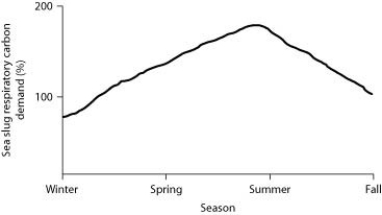Multiple Choice
Use the following information and figure to answer the question.
The sea slug Pteraeolidia ianthina (P. ianthina) can harbor living dinoflagellates (photosynthetic protists) in its skin. These endosymbiotic dinoflagellates reproduce quickly enough to maintain their populations. Low populations of the dinoflagellates do not affect the sea slugs very much, but high populations (> 5 x 10⁵ cells/mg of sea slug protein) can promote sea slug survival.
Percent of sea slug respiratory carbon demand provided by indwelling dinoflagellates.
Which of the following would be a potential disadvantage to the sea slugs of housing the dinoflagellates?
A) The CO₂ produced by the dinoflagellates would poison the sea slug.
B) The dinoflagellates would be an energy drain on the sea slug.
C) The sea slugs are exposed to predators when they spend time in the sunlit areas needed by the dinoflagellates.
D) The dinoflagellates will reduce the ability of the sea slugs to move.
Correct Answer:

Verified
Correct Answer:
Verified
Q39: The following table depicts characteristics of five
Q40: You have found a new prokaryote. What
Q41: Plantlike photosynthesis that releases O₂ occurs in<br>A)
Q42: Use the following information and graph to
Q43: Which of the following traits do archaeans
Q45: Use the following information and figure to
Q46: The following question refers to the figure.<br>In
Q47: Bacteria perform each of the following ecological
Q48: Use the information in the following paragraph
Q49: A fish that has been salt-cured subsequently